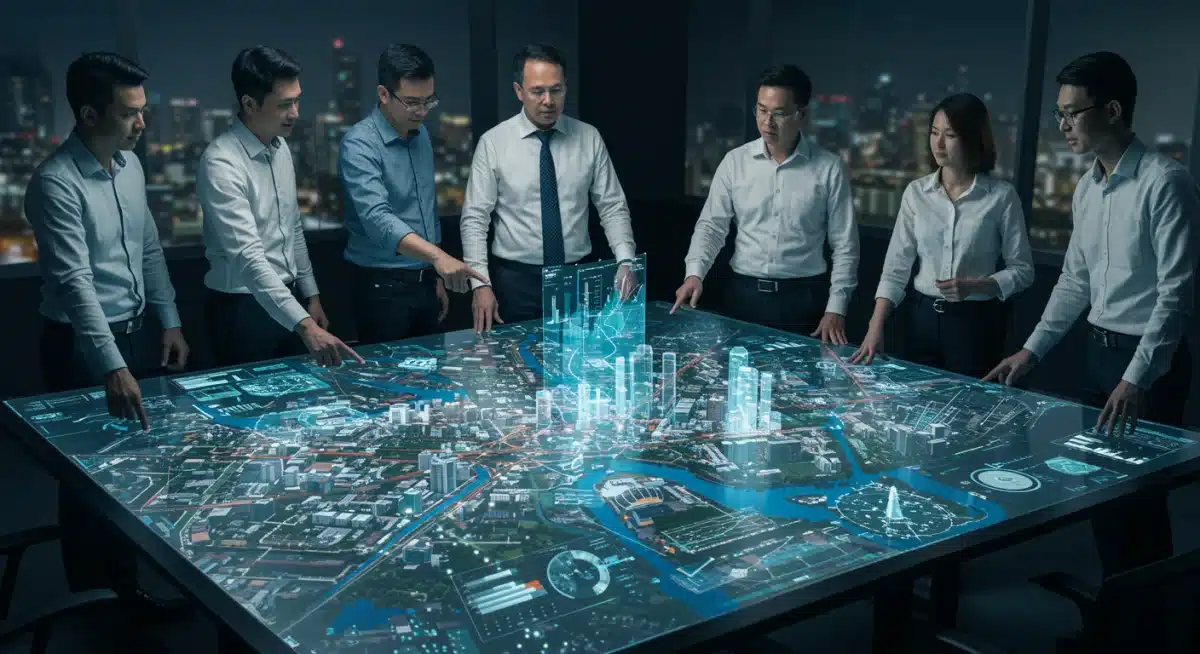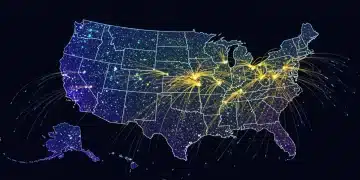Digital Twins for Smart Cities: US Urban Planning Revolution

The landscape of urban development in the United States is undergoing a significant transformation. Digital twins smart cities are emerging as a pivotal technology, promising to redefine how urban planners approach growth, infrastructure, and resource management.
The Rise of Digital Twins in Urban Planning
Digital twin technology, once primarily confined to manufacturing and aerospace, has rapidly expanded its footprint, now taking center stage in urban development. These virtual replicas of physical assets, processes, and systems are providing an unprecedented level of insight for city planners.
As of late 2024, numerous US cities are piloting and implementing digital twin platforms. These systems collect real-time data from sensors, IoT devices, and various urban infrastructure components. This data then feeds into sophisticated models that simulate everything from traffic patterns to energy consumption, allowing planners to test interventions virtually before deploying them physically.
Understanding the Core Concept
A digital twin is more than just a 3D model. It is a live, dynamic representation that continuously updates with real-world data. This constant feedback loop is what makes it such a powerful tool for predictive analysis and scenario planning in urban environments.
- Data Integration: Gathers information from IoT sensors, GIS, building information models (BIM), and public datasets.
- Real-time Monitoring: Provides immediate insights into urban operations and infrastructure performance.
- Predictive Analytics: Utilizes AI and machine learning to forecast future trends and potential issues.
- Scenario Planning: Allows planners to simulate the impact of various development projects or policy changes.
Enhanced Accuracy: The 95% Target by 2026
A significant development driving the adoption of digital twins smart cities is the projected 95% accuracy in simulating urban growth by 2026. This ambitious target, outlined by leading tech consultancies and urban planning organizations, signifies a critical milestone.
Achieving this level of accuracy means that urban planners will be able to predict the outcomes of their decisions with near-perfect precision. This includes everything from the impact of new residential developments on local services to the effectiveness of new public transportation routes. The implications for resource allocation, sustainability, and citizen well-being are immense.
Technological Advancements Fueling Precision
Several technological breakthroughs are converging to make this accuracy possible. Advances in artificial intelligence, particularly machine learning algorithms, are enabling more sophisticated data analysis and pattern recognition. The proliferation of 5G networks is also crucial, providing the low-latency, high-bandwidth connectivity required for massive real-time data streams.
Furthermore, improvements in sensor technology, including lidar and high-resolution satellite imagery, are providing richer, more granular data about the physical environment. This enhanced data quality directly translates into more accurate digital models and more reliable simulations.
Key Applications for US Planners
US urban planners are leveraging digital twins across a spectrum of applications. These range from optimizing traffic flow to designing more resilient infrastructure. The technology offers a holistic view of the urban ecosystem, fostering integrated decision-making.
One primary application involves infrastructure planning. Before breaking ground on a new bridge or public building, a digital twin can simulate its entire lifecycle, from construction impact to long-term operational efficiency and maintenance needs. This proactive approach significantly reduces risks and costs associated with large-scale projects.
Optimizing Urban Mobility
Traffic congestion remains a major challenge in many US cities. Digital twins offer a dynamic solution by modeling traffic patterns in real-time, identifying bottlenecks, and simulating the effects of various interventions. This could include adjusting traffic light timings, rerouting public transport, or even planning for autonomous vehicle integration.
- Traffic Flow Simulation: Predicts congestion points and optimizes routing.
- Public Transit Planning: Evaluates new routes and schedules for efficiency.
- Emergency Response: Models optimal routes for first responders during critical events.
Challenges and Considerations for Implementation
While the benefits of digital twins smart cities are clear, their widespread implementation in the US is not without challenges. Data privacy, cybersecurity, and the significant upfront investment required are critical considerations for city governments.
Ensuring the ethical use of data collected from citizens and infrastructure is paramount. Robust cybersecurity measures are also essential to protect these complex systems from malicious attacks. Furthermore, the development and maintenance of high-fidelity digital twins require substantial financial and technical resources, posing a barrier for smaller municipalities.

Data Governance and Security
Establishing clear data governance policies is crucial. Cities must define who owns the data, how it is collected, stored, and used, and how citizen privacy is protected. This often involves collaboration between multiple stakeholders, including government agencies, private companies, and community groups.
The interconnected nature of digital twin systems also makes them potential targets for cyberattacks. Implementing multi-layered security protocols, including encryption, access controls, and regular audits, is non-negotiable to maintain the integrity and reliability of the urban digital twin.
Economic and Environmental Impact
The adoption of digital twins smart cities is poised to deliver substantial economic and environmental benefits across the US. By optimizing resource usage and improving operational efficiency, cities can achieve significant cost savings and reduce their ecological footprint.
Economically, digital twins can lead to more efficient infrastructure projects, reduced operational costs for city services, and the creation of new high-tech jobs in data science and urban analytics. Environmentally, these systems can help cities meet sustainability goals by optimizing energy consumption, managing waste more effectively, and planning for green infrastructure.
Sustainable Urban Development
Digital twins enable cities to simulate the environmental impact of various development scenarios. This includes assessing carbon emissions from new buildings, predicting the effectiveness of urban greening initiatives, and optimizing water management systems to combat scarcity. The ability to model these impacts before implementation allows for more sustainable and resilient urban planning.
- Energy Optimization: Identifies areas for reducing energy consumption in buildings and infrastructure.
- Waste Management: Simulates optimal routes for waste collection and resource recovery.
- Climate Resilience: Models the impact of climate change scenarios, such as rising sea levels or extreme weather events.
The Future of Urban Planning in the US
Looking ahead to 2026 and beyond, the integration of digital twins smart cities is set to become a standard practice in urban planning across the US. The drive for 95% accuracy is not just a technical goal but a vision for more responsive, efficient, and livable cities.
This evolution will likely see digital twins becoming more interconnected, forming a ‘system of systems’ where individual city twins can communicate and share insights. This could lead to regional planning initiatives and a more harmonized approach to infrastructure development across states.
Policy and Investment Outlook
Federal and state governments are increasingly recognizing the strategic importance of this technology. We anticipate seeing more dedicated funding initiatives, research grants, and policy frameworks designed to support the adoption and responsible development of digital twin platforms in urban settings. Public-private partnerships will also play a crucial role in accelerating this transformation.
| Key Aspect | Impact on US Urban Planning |
|---|---|
| Accuracy Target | 95% accuracy in urban growth simulation by 2026, enabling precise decision-making. |
| Core Functionality | Real-time data integration, predictive analytics, and extensive scenario planning for urban development. |
| Key Applications | Optimizing traffic, infrastructure lifecycle management, and sustainable resource allocation. |
| Challenges | Addressing data privacy, cybersecurity, and significant initial investment costs. |
Frequently Asked Questions About Digital Twins for Smart Cities
A digital twin for smart cities is a virtual replica of a city’s physical assets, systems, and processes. It continuously updates with real-time data from sensors and IoT devices, allowing urban planners to monitor, analyze, and simulate urban environments for better decision-making.
This accuracy will be achieved through advancements in AI, machine learning, and 5G connectivity. These technologies enable more sophisticated data analysis, pattern recognition, and real-time data streaming, leading to highly precise urban growth simulations and predictive capabilities for planners.
US urban planners benefit from enhanced decision-making, optimized resource allocation, and improved infrastructure planning. Digital twins facilitate scenario testing, enable better traffic management, and support sustainable development goals by simulating environmental impacts before implementation.
Cities encounter significant challenges including ensuring data privacy and robust cybersecurity measures. Additionally, the substantial upfront investment in technology and expertise, along with establishing effective data governance policies, are critical hurdles for successful implementation.
Digital twins enable sustainable development by optimizing energy consumption, improving waste management, and modeling the environmental impact of urban projects. They help cities plan for climate resilience and achieve sustainability goals through data-driven insights and simulations.
Looking Ahead
The rapid evolution of digital twins smart cities signifies a pivotal shift in urban governance. As the 95% accuracy target for urban growth simulation by 2026 draws closer, US cities are poised to harness unprecedented data-driven insights. This will fundamentally reshape policy-making, infrastructure development, and environmental strategies. Stakeholders must continue to focus on robust data governance and cybersecurity while fostering public-private collaborations to fully realize the transformative potential of this technology. The coming years will undoubtedly define a new era of proactive and resilient urban planning.





